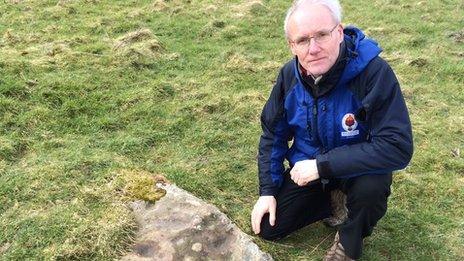Bronze Age rock art uncovered in Brecon Beacons
- Published
Experts claim the stone probably served as a way marker for prehistoric farming communities
Rare, prehistoric rock art which could be more than 4,000 years old has been discovered in the Brecon Beacons.
The Bronze Age discovery was made late last year by national park geologist Alan Bowring.
Experts claim the stone probably served as a way marker for farming communities.
Similar stones have been found in other parts of Britain but they are thought to be rare in mid Wales.
Its exact location in the Brecon Beacons is being kept a secret and news of its discovery comes after archaeologists found a similar ancient rock in the Scottish Highlands.
The Welsh stone is about 1.45m (4ft 9in) long and half a metre (1ft 8 in) wide, with 12 cup (hollow) marks of various shapes and sizes on the face.
It now lies flat on the ground but experts say it could have once stood upright.
Hidden features
Mr Bowring was working on land maintained by the National Trust when he spotted the rock.
Sensing it was unusual, he sought advice from national park archaeologist Natalie Ward, who had experience of recording similar artefacts in the north of England.
"I often find myself working and walking in remote locations, and encountering hidden features in the landscape of south and mid Wales that few others will have seen," said Mr Bowring.
"But this chance discovery, made whilst looking for clues to the site's exciting geological history, appears to be significant in our understanding of human cultural history in the region."
The National Trust's own archaeological survey had already highlighted Bronze Age features in the area, giving some context to the stone's past.
Dr George Nash, archaeologist and specialist in prehistoric and contemporary art at Bristol University, confirmed Mr Bowring had discovered the first prehistoric rock engraved panel recorded in the Brecon Beacons.
Dr Nash added that based on the shape of the stone and its engravings it probably came from the early to middle Bronze Age period - 2500 BC to 1500 BC - and it probably served as a way marker.

Alan Bowring discovered the stone when he was working in the Brecon Beacons
"We might have been able to predict a discovery of this kind considering the large amount of prehistoric ritual sites in the Brecon Beacons but this is the first evidence of prehistoric rock art to be ever recorded [in the Beacons]," Dr Nash said.
"There are no other later prehistoric standing stones within this part of Wales that are cup marked, making this one rather unique."
He said the cup marks were the most common later prehistoric rock art form in Britain and Europe, but their occurrence in mid Wales was rare.
- Published3 March 2014
- Published27 February 2014